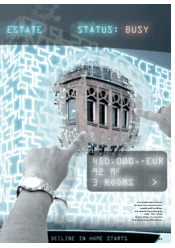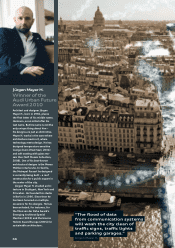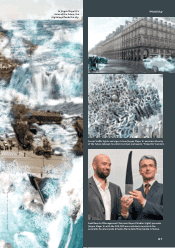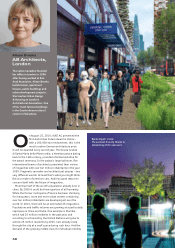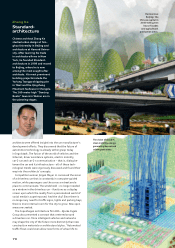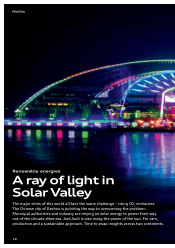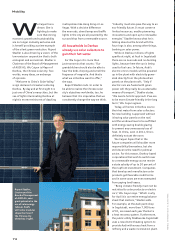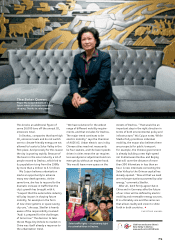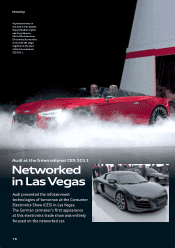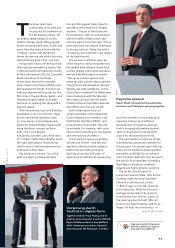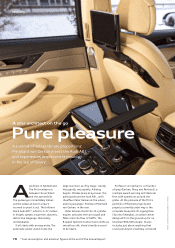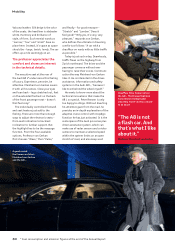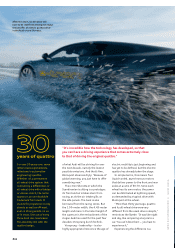Audi 2010 Annual Report Download - page 76
Download and view the complete annual report
Please find page 76 of the 2010 Audi annual report below. You can navigate through the pages in the report by either clicking on the pages listed below, or by using the keyword search tool below to find specific information within the annual report.
74
Mobility
Wu Cuiyun has a
dream. She is
fi ghting to make
sure that strong
economic growth and sustainability
are no longer mutually exclusive and
is herself providing a prime example
of the silent green revolution. Rupert
Stadler is also driven by a vision: of the
low-emission corporation that is both
ecological and economical. Stadler is
Chairman of the Board of Management
of AUDI AG, Wu Cuiyun is Mayor of
Dezhou, the Chinese solar city. Two
worlds, many ideas, an exchange
of opinions.
“Welcome to China’s Solar Valley,”
a sign declares to travelers entering
Dezhou. By day and at fi rst sight it is
just one of China’s many cities, but the
sea of lights illuminating Dezhou at
night is more reminiscent of dazzling
metropolises like Hong Kong or Las
Vegas. With a decisive diff erence:
the neon ads, street lamps and traffi c
lights in the city are all powered by the
sun and thus from a renewable source.
For Wu Cuiyun it is more than
just economics that counts: “Our
grandchildren should also be able to
hear the birds chirping and smell the
fragrance of magnolia. And that is
what we in Dezhou want to off er,”
she says.
Rupert Stadler nods. In order to
be able to realize the Chinese solar
city’s objectives worldwide, too, he
believes that it is imperative that we
consistently change the way we think.
“Industry must also pave the way to an
eco-friendly future. It must conserve
limited resources, enable pioneering
innovations and open up to renewable
energies.” Stadler knows what he is
talking about as the brand with the
four rings is also, among other things,
banking on solar power.
While in Dezhou millions of lights
sparkle at night, at Audi in Ingolstadt
there are no neon ads and no dazzling
lights, because here the sun is being
used to fuel cars. In future, Audi’s
electric e-tron models will be powered
up in the plant with electricity gener-
ated directly from the photovoltaic
panels on the plant roofs. “Only if
electric cars are fueled with green
power will they really be a sustainable
means of transport,” Stadler states.
“We need a holistic approach if we are
to be more climate-friendly in the long
term,” Wu Cuiyun agrees.
Today, all homes in Dezhou source
their hot water from solar collectors.
No new building is approved without
it having solar panels on the roof,
and the windows have to be outfi tted
with energy-saving double glazing
to prevent any unnecessary loss of
heat. In China, even in 2011, this is
defi nitely not yet the norm.
Wu Cuiyun hopes that in the
future companies will shoulder more
responsibility themselves, but she
still discerns the need for political
action. For this reason, Dezhou-based
corporations that wish to switch over
to a renewable energy source receive
a state subsidy of up to 20 percent of
their upfront investment. Companies
that develop and manufacture solar
products get favorable credit terms
and in some cases are even exempted
from paying land leases.
“Being climate-friendly must not be
restricted to solar products or electric
cars,” Wu Cuiyun says. “Which is why
for Audi it is our entire energy balance
sheet that matters,” Stadler adds.
For example, at the Audi paint shop
in Ingolstadt, more than 7,000 tons
of CO2 are saved each year thanks to
a heat recovery system. Furthermore,
the public utility Stadtwerke Ingolstadt
uses a new district heating system to
provide Audi with excess heat from a
refi nery and a waste incineration plant.
All households in Dezhou
already use solar collectors to
gain their hot water.
Rupert Stadler,
Chairman of the
Board of Management
of AUDI AG, sees
great potential in the
use of solar energy
(above). Roofs
with solar modules
shape the face of
the Chinese city
of Dezhou (right).
PHOTOS | KATHARINA HESSE (3); OLIVER MARK



